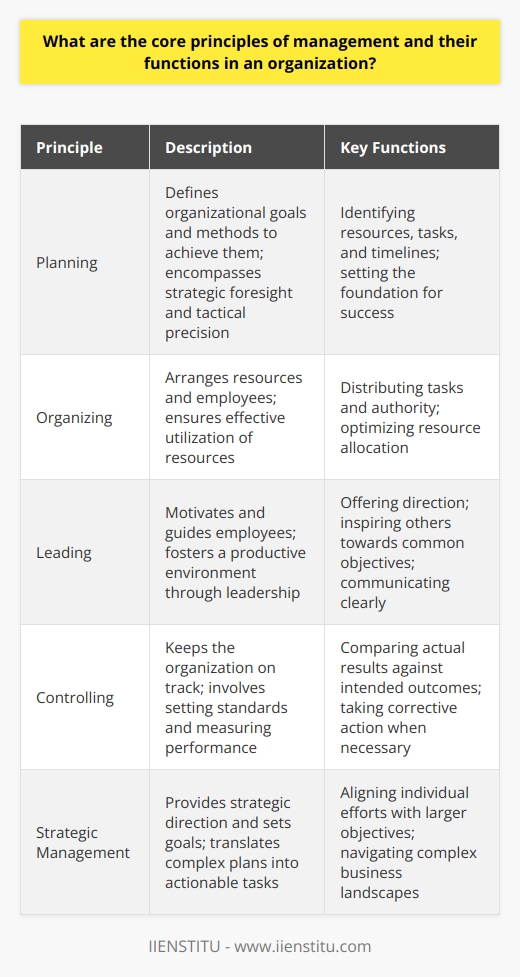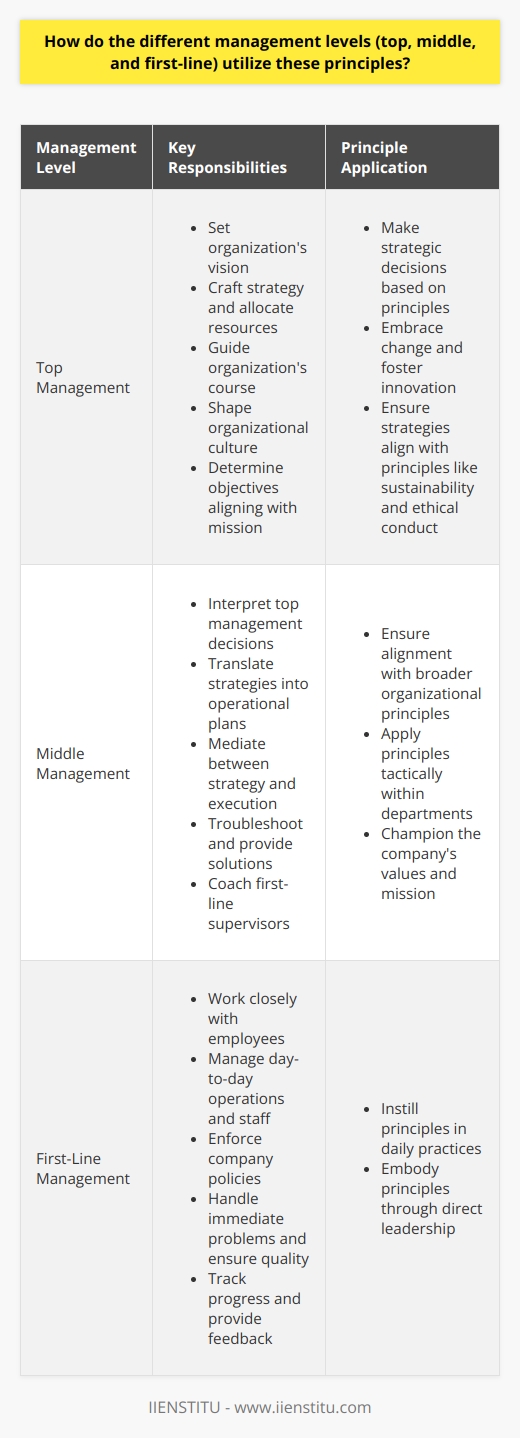
Management is a complex discipline that evolves with time, incorporating new methodologies and philosophies that respond to the changing dynamics of business and organizational needs.
All managers, irrespective of the sector they work in or the size of the teams they lead, operate under a universal set of management principles that guide their decisions and strategies.
This blog post aims to distill the essence of these principles, providing a clear understanding that is critical for everyone from seasoned professionals to those pursuing mba online or certificate courses online. We will break down the key concepts of management and offer tangible examples to illustrate their application in real-world scenarios.
Introduction
Management is a pivotal aspect of any organization's success. It encompasses planning, organizing, leading, and controlling an organization's resources to achieve certain objectives efficient and effectively.
Fundamentally, understanding management principles is akin to understanding the rules of engagement within the business world, dictating how goals are accomplished, strategies are devised, and how challenges are conquered.
The importance of firm management foundations cannot be overemphasized, as they provide the framework through which all business activities are aligned toward achieving the overall vision and mission of the company.
This blog post is geared towards elucidating these principles, offering a deep dive into their significance, historical evolution, and practical application in today's business landscape.
Fundamental Principles of Management
The very foundation of management is built on established principles that have stood the test of time. These principles consist of fundamental truths that are universally applicable in various management scenarios regardless of organizational context.
The role of management principles in effective business operation
Management principles are the bedrock upon which successful business operation rests. They guide managers in forming strategies, in decision-making processes, and in the creation of organizational structures that are both scalable and responsive to the dynamic needs of the marketplace.
Brief historical overview of management thought
From the classical approach exemplified by the likes of Henri Fayol, who formulated concepts such as division of work and authority, to the modern emphasis on human relations and behavioral sciences, management thought has evolved over the years. This historical perspective sheds light on how contemporary management principles have been shaped by both past successes and failures.
Core Management Principles Explained
The core principles of management are divided into four primary categories: planning, organizing, leading, and controlling. These serve as the primary pillars upon which the management process rests.
Planning
Planning is a cornerstone of management principles. It is the initial step in the management process, where managers outline strategies and actions to achieve specified goals.
Definition and importance of planning:
Planning involves setting objectives and determining the most appropriate course of action to attain them. This step is critical as it establishes a direction for the organization and provides a benchmark against which actual performance can be measured.
Steps involved in the planning process:
The planning process typically begins with establishing objectives, followed by devising strategies, setting up policies, creating procedures, scheduling tasks, and budgeting resources. Each step is integral to paving the way for successful execution.
Real-world example of effective planning:
An effective example of planning in action could involve a tech startup that carefully strategizes its product development phases, aligns them with market trends, and meticulously plans its launch sequence to capitalize on emerging consumer needs.
Organizing
Effective organization in management is pivotal for ensuring resources are optimally allocated and directed toward the pursuit of planned objectives.
Understanding the organizational structure:
The organizational structure lays the framework for how tasks are distributed, how authority flows, and how coordinated efforts are facilitated within the organization. An efficient structure adapts to the plan and provides stability and flexibility in operations.
Resource allocation and departmentalization:
Organizing also involves allocating resources strategically across various departments and defining roles clearly. This can enable better synergy and enhance productivity across different segments of the organization.
Case study on successful organizational restructuring:
A quintessential case study might detail how a multinational corporation effectively restructured its divisions to enhance global coordination, resulting in improved efficiency and a unified corporate culture.
Leading
Leading pertains to the human element of management, which is indispensable for inspiring and motivating employees towards fulfilling organizational goals.
Characteristics of effective leadership:
Effective leaders exhibit traits such as vision, communication skills, integrity, enthusiasm, and empathy. They are adept at influencing behavior and fostering an environment conducive to achieving set targets.
The impact of leadership styles on team dynamics:
The choice of leadership style—be it autocratic, democratic, or laissez-faire—can significantly affect team morale, productivity, and ultimately, the success of projects.
Illustration with a leadership success story:
An inspiring leadership success story could depict how a CEO transformed a flailing business into a thriving enterprise through strategic vision, effective communication, and by cultivating a culture of innovation and resilience.
Controlling
Controlling is an essential management principle that involves monitoring performance and taking corrective actions to align outcomes with objectives.
The concept of performance measurement:
To exert control effectively, management must establish performance standards, measure actual performance, compare it with established standards, and take corrective action where necessary.
Tools and techniques for control in management:
Various tools such as balanced scorecards, budgetary controls, and performance audits can be employed to ensure that the organization is on the correct path towards achieving its objectives.
Anecdote of implementing control mechanisms:
An anecdote in this context could relate to how a retail chain implemented strict inventory controls to minimize stockouts and overstocking, thus achieving significant savings and improving customer satisfaction.
Key Management Concepts in Practice
Theoretical knowledge of management concepts is valuable, but it is their practical application that truly tests their efficacy. The following sections detail how core management concepts are applied in everyday business scenarios.
The Decision-Making Process
At the heart of management is the decision-making process, which is vital for guiding the direction of the organization.
Steps for making informed management decisions
The decision-making process typically starts with problem identification, followed by alternative generation, evaluation of alternatives, the selection of the best alternative, implementation, and finally, evaluation of outcomes.
The role of decision-making in achieving business goals
Quality decisions align resources, effort, and strategies with business objectives, enabling organizations to navigate competitive markets and respond to challenges with agility.
Example of a transformative management decision
A transformative management decision could be exemplified by a company that decided to pivot from a traditional business model to a digital-first approach, successfully tapping into new market segments and catapulting its brand to a new level of industry prominence.
Communication and Interpersonal Skills
Communication and interpersonal skills are essential ingredients in the recipe for effective management. They ensure that all stakeholders are aligned and motivated toward common goals.
The significance of communication in management
Effective communication ensures transparency, prevents misunderstandings, and fosters a sense of community within the organization, making it an indispensable tool for managers at all levels.
Techniques for fostering effective communication
Techniques such as active listening, open-door policies, regular team meetings, and the use of collaborative platforms can greatly enhance the flow of information and the overall communication climate within an organization.
Case scenario demonstrating communication success
A classic case of communication success might involve a company that restructured its internal communication strategy to facilitate cross-departmental collaboration, resulting in a more cohesive work environment and enhanced productivity.
Strategic Thinking and Innovation
Strategic thinking and innovation are critical for sustaining long-term competitive advantage and require managers to look beyond the immediate operational concerns.
Long-term planning and competitive analysis
Strategic thinking encompasses long-term planning, continuous competitive analysis, and the anticipation of future trends and disruptions that may affect the business landscape.
Encouraging innovation within the organization
Creating an environment that encourages innovation involves investing in staff training, research and development, and rewarding creativity and risk-taking.
Historical exemplar of strategic turnaround
One historical exemplar of strategic management was when IBM shifted its focus from hardware to software and services in response to market changes, thereby achieving a dramatic turnaround in its business fortunes.
Challenges in Applying Management Principles
Management principles, while straightforward in theory, often face challenges when applied due to an ever-changing business environment.
Adapting to Changes in Business Environment
The business landscape is continually evolving, and management must adapt its principles accordingly to maintain relevance and effectiveness.
Evolution of management theories and practices
Theories and practices in management are in a state of constant flux, necessitating a nimble and forward-thinking approach from leaders to keep pace with technological advancements, changing consumer behaviors, and global market dynamics.
Identifying and responding to external and internal factors
Managers must have the ability to identify signals of change—be they technological, regulatory, or cultural—and implement timely responses to mitigate risks and capitalize on opportunities.
Ethical Considerations and Corporate Social Responsibility (CSR)
Ethics and CSR have become integral to modern management practices, influencing everything from decision-making to stakeholder engagement.
Ethical dilemmas in decision-making
Managers often face ethical dilemmas that require balancing profitability with social and environmental responsibilities. How they navigate these dilemmas can significantly affect their company's image and stakeholder trust.
Best practices for upholding ethical standards
Implementing codes of conduct, holding regular ethics training, and establishing clear accountability mechanisms are best practices that help reinforce ethical standards in the workplace.
Globalization and Managing Diversity
The global nature of modern businesses calls for a nuanced approach to management that not only acknowledges but also leverages diversity.
The significance of cultural awareness and inclusion
Cultural awareness and inclusion foster a more dynamic and innovative workforce while helping global organizations avoid missteps that could lead to market alienation.
Strategies for managing a diverse workforce
Proactive diversity training, inclusive policies, and culturally sensitive communication strategies are essential for managing a diverse global workforce effectively.
A case of successful multicultural management
A compelling case would describe how a multinational company implemented diversity and inclusion programs that resulted in higher employee satisfaction, better problem-solving, and a significant increase in market share across different regions.
The principles of management are foundational to any organization's functioning. We've explored several core principles and their importance in the context of contemporary business operations—from the necessity of robust planning and organizing to the imperatives of sound leadership and precise control measures.
The ongoing importance of refining these skills cannot be overstated, as they are critical for navigating the complexities of a rapidly changing, globalized business environment. Adopting a mindset of continuous improvement and adaptation is crucial for today's managers.
Furthermore, we encourage readers to actively seek further learning and development opportunities to remain competitive and effective in their management careers and practices.
Recommendations for Further Reading and Resources
In an ever-evolving field like management, continuous learning is paramount. We recommend tapping into a myriad of resources to deepen your understanding and enhance your management acumen.
A curated list of books, articles, and online courses
For those interested, there's a wealth of knowledge to be found in books such as "The Effective Executive" by Peter Drucker or "Good to Great" by Jim Collins. Articles in the Harvard Business Review and journals such as the Academy of Management Review offer insightful perspectives on current management trends. Additionally, enrolling in mba online programs or certificate courses online can significantly augment one's expertise and skills in management.
Professional organizations and networking opportunities
Professional organizations provide invaluable networking opportunities, mentorship, and knowledge exchange that can help in nurturing your management career. Groups such as the American Management Association (AMA) or the Chartered Management Institute (CMI) offer numerous resources and community connections for management professionals.
Understanding and implementing the principles of management can be a challenging yet rewarding endeavor. We invite you to engage with this content by sharing your comments, questions, or experiences below. Furthermore, we suggest that you take practical steps towards applying these management principles within your career or business to drive success and professional growth.
Frequently Asked Questions
What are the core principles of management and their functions in an organization?
Core Principles of Management
Management stands as the backbone of any successful organization. It sets the groundwork for efficiency, effectiveness, and consistent progress. The central tenets of management revolve around core principles. These principles guide managers in their everyday decisions.
Planning as a Foundational Step
Planning is the first, vital step. It defines organizational goals and the methods to achieve them. Managers identify resources, tasks, and timelines during this phase. Planning encompasses both strategic foresight and tactical precision.
Organizing Resources and Personnel
Organizing follows planning. This step involves arranging resources and employees. It ensures that personnel utilize resources effectively. Proper organization distributes tasks and authority appropriately.
Leading with Vision and Influence
Leading entails motivating and guiding employees. Managers foster a productive environment through leadership. They offer direction and inspire others towards common objectives. Effective leaders also communicate clearly and command respect.
Controlling to Ensure Goals are Met
The controlling function keeps the organization on track. It involves setting standards and measuring performance. Here, managers compare actual results against intended outcomes. They take corrective action when necessary.
Functions of Management in an Organization
Organizations rely on management for coordination and direction. Management functions interlink to produce desired results.
Strategic Direction and Goal Setting
Managers provide strategic direction and set goals. They translate complex plans into actionable tasks. Goal setting aligns individual efforts with larger objectives.
Resource Allocation and Optimization
Optimal resource use is a key managerial function. Managers allocate resources where most effective. They also strive for cost efficiency and minimal waste.
Team Building and Employee Development
Developing a cohesive team is another function. Managers recruit, train, and mentor staff. They foster a skilled, reliable workforce through continuous development.
Performance Measurement and Management
Performance management reflects the control function. Managers track progress and offer feedback. They aim for ongoing improvement and accountability.
Change Implementation and Risk Management
Lastly, managers handle change and mitigate risks. They steer the organization through transitions and challenges. Risk management includes foreseeing and preventing potential issues.
Management principles and functions are interconnected. They form a dynamic system that supports organizational success. Managers apply these principles to navigate complex business landscapes. Through their efforts, organizations evolve and thrive.

How do the different management levels (top, middle, and first-line) utilize these principles?
Understanding Management Hierarchy
Top Management and Principles Use
Top managers set the organization's vision. They craft strategy and allocate resources. These leaders guide the organization's course. They use principles to make strategic decisions. Principles like sustainability and ethical conduct inform their strategies. They must embrace change and foster innovation. Top managers use principles to shape culture. They determine objectives aligning with the organizational mission. Their decisions reflect principles at the strategic level.
Middle Management's Role in Applying Principles
Middle managers interpret top management decisions. They translate strategies into operational plans. Middle managers mediate between strategy and execution. They ensure alignment with broader organizational principles. Middle managers troubleshoot and provide solutions. They apply principles tactically within departments. Middle managers coach first-line supervisors. They champion the company's values and mission.
First-Line Managers and Principle Execution
First-line managers work closely with employees. They manage day-to-day operations and staff. First-line managers enforce company policies. They instill principles in daily practices. They handle immediate problems and ensure quality. First-line managers also track progress and provide feedback. They embody principles through direct leadership.
Applying Principles Across Management Levels
Management levels function interdependently. All levels rely on core principles for cohesion. Each level applies these principles differently.
Top management thinks long-term and abstractly.
Middle management connects strategy with practical application.
First-line managers implement actions and oversee tasks.
All aim for organizational success. Principle utilization thus differs in scope and immediacy. Each level ensures principles flow throughout the organization. They use these guidelines to maintain integrity and performance. Understanding each level's approach clarifies their roles. It highlights the management structure's complexity and interconnectedness.

Can you explain the relevance of principles such as unity of command, division of work, and scalar chain in modern management practices?
Unity of Command
The concept of unity of command remains vital today. It dictates that an employee should receive orders from one supervisor only. This principle limits confusion. Clear supervision improves responsibility delineation. Consequently, workers have a singular focus. Staff morale benefits from such clarity.
Unity of command aligns with modern flat structures. It enables quick decision-making. Moreover, it empowers workers. In team settings, it fosters accountability. Accountability facilitates stronger engagement. Therefore, modern management incorporates this principle effectively.
Division of Work
Division of work boosts organizational efficiency. It advocates for specialization. Employees focus on specific tasks. Specialization increases productivity and expertise. Efficiencies arise from task repetition. Skills sharpen over time. This principle parallels contemporary practice.
Modern workplaces emphasize core competencies. They leverage specialized roles. Cross-functional teams still rely on the division of work. Tasks distribute according to ability. As a result, project outcomes improve. Work division also supports outsourcing strategies. Companies now focus on their primary activities. Non-core tasks often get outsourced.
Scalar Chain
The concept of scalar chain refers to hierarchy. A clear hierarchy ensures structured communication. It denotes command layers within an organization. Scalar chains clarify authority levels. They ease the flow of information. This idea intersects with contemporary principles.
Transparent hierarchies demarcate reporting relationships. They provide predictable communication paths. Yet, modern contexts often demand flexibility. Thus, modern management has adapted. Lateral communication becomes more common. Informal networks complement formal chains. To remain agile, companies often bypass strict hierarchies. Still, management must balance agility with coherence. Scalar chains provide a useful framework for this balance.
Management continues to evolve. Yet, foundational principles retain their relevance. Unity of command prevents disorder. Division of work drives efficiencies. Scalar chains provide organizational clarity. Modern management practices adapt these principles. They incorporate them into innovative management frameworks.
Successful managers grasp these enduring concepts. They apply them judiciously in their companies. In doing so, they navigate the complexity of contemporary business environments.



